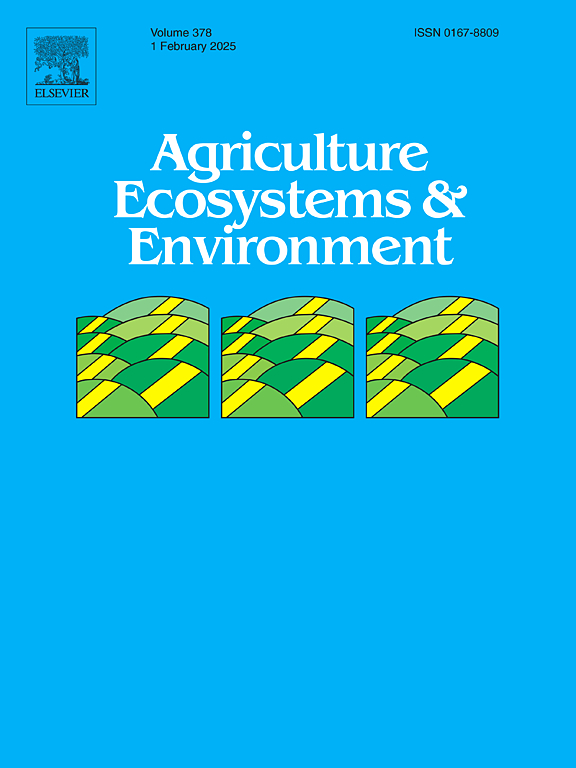Sphagnum cultivation enhances soil carbon stock by alleviating microbial phosphorus limitation
IF 6
1区 农林科学
Q1 AGRICULTURE, MULTIDISCIPLINARY
引用次数: 0
Abstract
Sphagnum cultivation has several ecological environmental effects, including land restoration, and economic benefits. However, complex mechanisms involving the interaction of microbial structure, functions, and nutrient limitations under Sphagnum cultivation are still unclear. In this study, we explored microbial nutrient limitation by examining the soil extracellular enzyme stoichiometry across different years of Sphagnum cultivation and further analyzed the impacts of Sphagnum cultivation on soil properties, microbial communities, and microbial functional genes. The results revealed that microbial carbon (C) limitation increased with the years of Sphagnum cultivation. However, Sphagnum cultivation alleviated microbial phosphorus (P) limitation. Sphagnum cultivation significantly decreased the microbial diversity, and microorganisms shifted from copiotrophic (r-) to oligotrophic (K-) groups, which was consistent with the observed reduction in the 16S rRNA operon copy number within the microbial community. However, the functions related to C, nitrogen (N), P, and sulfur cycles displayed a similar “decrease–peak–increase” trend across different years of Sphagnum cultivation. Microbial C limitation increased mainly through increasing the expression of functional genes involved in C cycling, whereas microbial P limitation decreased mainly through decreasing the expression of functional genes involved in N and P cycling with the years of Sphagnum cultivation. Therefore, microbial functional attributes were the key factors driving the response of soil microbial metabolic constraints to the chronosequences of Sphagnum cultivation. Additionally, soil organic C (SOC) content increased and total N and total P contents first decreased and then increased with the years of Sphagnum cultivation. The SOC content was significantly higher by 110.9 % and 178.8 % on average in paddies under long-term Sphagnum cultivation (10 and 20 years, respectively) than in those without Sphagnum cultivation. These findings demonstrated the positive influence of Sphagnum farming on soil ecosystems, particularly in boosting organic C sequestration, which is crucial for combating global climate change.
沼地种植通过缓解微生物磷限制来增加土壤碳储量
泥鳅的种植具有多种生态环境效应,包括土地修复效应和经济效益。然而,关于藻培养中微生物结构、功能和营养限制相互作用的复杂机制尚不清楚。在本研究中,我们通过测定不同年份Sphagnum栽培土壤胞外酶化学计量来探索微生物养分限制,并进一步分析Sphagnum栽培对土壤性质、微生物群落和微生物功能基因的影响。结果表明,微生物碳(C)限制随栽培年限的增加而增加。而植藻可缓解微生物磷(P)的限制。Sphagnum的培养显著降低了微生物的多样性,微生物从共营养型(r-)向寡营养型(K-)转变,这与观察到的微生物群落中16S rRNA操纵子拷贝数的减少是一致的。而碳、氮、磷、硫循环相关功能在不同栽培年限间表现出相似的“减-峰-增”趋势。随着栽培年限的增加,微生物C限制主要通过增加参与碳循环的功能基因的表达而增加,而微生物P限制主要通过减少参与氮和磷循环的功能基因的表达而降低。因此,微生物功能属性是驱动土壤微生物代谢约束对Sphagnum栽培时间序列响应的关键因素。随着栽培年限的增加,土壤有机碳(SOC)含量增加,全氮和全磷含量先降低后增加。长期栽培(10年和20年)稻田土壤有机碳含量显著高于未栽培稻田,分别提高了110.9 %和178.8 %。这些发现证明了泥炭种植对土壤生态系统的积极影响,特别是在促进有机碳封存方面,这对应对全球气候变化至关重要。
本文章由计算机程序翻译,如有差异,请以英文原文为准。
求助全文
约1分钟内获得全文
求助全文
来源期刊

Agriculture, Ecosystems & Environment
环境科学-环境科学
CiteScore
11.70
自引率
9.10%
发文量
392
审稿时长
26 days
期刊介绍:
Agriculture, Ecosystems and Environment publishes scientific articles dealing with the interface between agroecosystems and the natural environment, specifically how agriculture influences the environment and how changes in that environment impact agroecosystems. Preference is given to papers from experimental and observational research at the field, system or landscape level, from studies that enhance our understanding of processes using data-based biophysical modelling, and papers that bridge scientific disciplines and integrate knowledge. All papers should be placed in an international or wide comparative context.
 求助内容:
求助内容: 应助结果提醒方式:
应助结果提醒方式:


